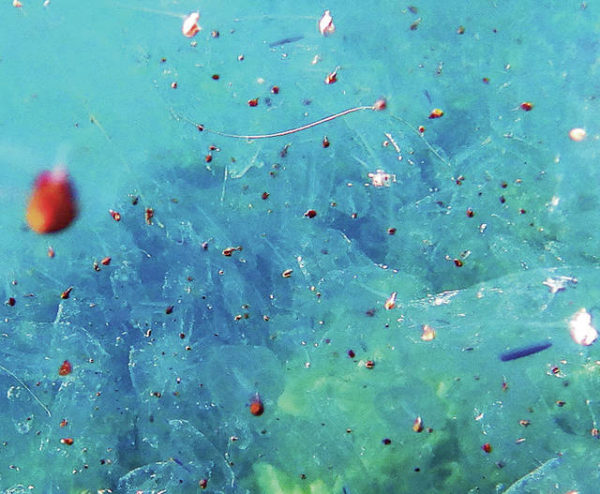Published in the Ocean Watch column, Honolulu Star-Advertiser © Susan Scott
June 9, 2018
This week I swam with several million of the weirdest and most captivating animals off Orpheus Island in the Great Barrier Reef Marine Park. Although I’ve been in the water with these creatures before, never have I seen this species, nor have I had to push through walls of their gelatinous bodies. These were salps, so dense I could barely see the purple, pink and green coral heads 3 feet below.
I’m glad I knew about the existence of salps, because their clear, jellylike bodies would otherwise have alarmed Craig and me here in tropical Australia, where jellyfish can kill.
 Salp bodies obscure the green coral below.
Salp bodies obscure the green coral below.
At top, with tail, is a larvacean.
©2018 Susan Scott
But salps are not related to jellyfish or their stinging relatives. Therefore, having the harmless pulsing creatures bumping my skin was a pleasant experience, sort of like swimming with marshmallows.
Salps come in various shapes and sizes depending on the species. The clear, delicate animals that had drifted into our anchorage at Pioneer Bay were 1 to 2 inches long (creatures in the class Thaliacea, for those who want to look them up). The barrel-shaped bodies had openings at each end.
These little animals get around by jet propulsion, contracting their walls to suck water in one end and push it out the other. By opening and closing either end, a salp of this type can travel in any direction. The pumping water also brings in planktonic food and oxygen. Carbon dioxide, metabolic wastes and sperm exit the other end.
As we floated through the salp walls, we noticed another species in the mass, tadpolelike creatures with pinhead bodies and tails a couple inches long. These are another type of plankton related to salps but belonging to a different class of animals called larvacea (no common name).
Larvaceans build a gelatinous “house” about the size of a walnut that completely encloses their tiny bodies. The house contains a screen that filters out all but the tiniest bits of plankton, called nanoplankton, too small for most filter feeders. As the larvacean beats its tail, the food sifts in.
One larvacean can eat 250,000 plant cells a day. Because this is hard on the flimsy house, the creature replaces it every four hours. A larvacean can build four to 16 houses a day, depending on conditions, or 46 houses in their three- to 10-day life span.
Salps and larvaceans are some of the fastest-growing animals in the ocean. Under ideal conditions the creatures form massive swarms containing millions of individuals. That many short-lived animals generate a lot of waste material, but the ocean, of course, recycles it. The gelatinous animals’ dead bodies sink fast, providing nutrients to midwater and bottom-dwelling creatures.
Snorkeling among masses of salps and larvaceans was not what we expected when we jumped into the water here in the Great Barrier Reef Marine Park. But then again, that’s why we do it.